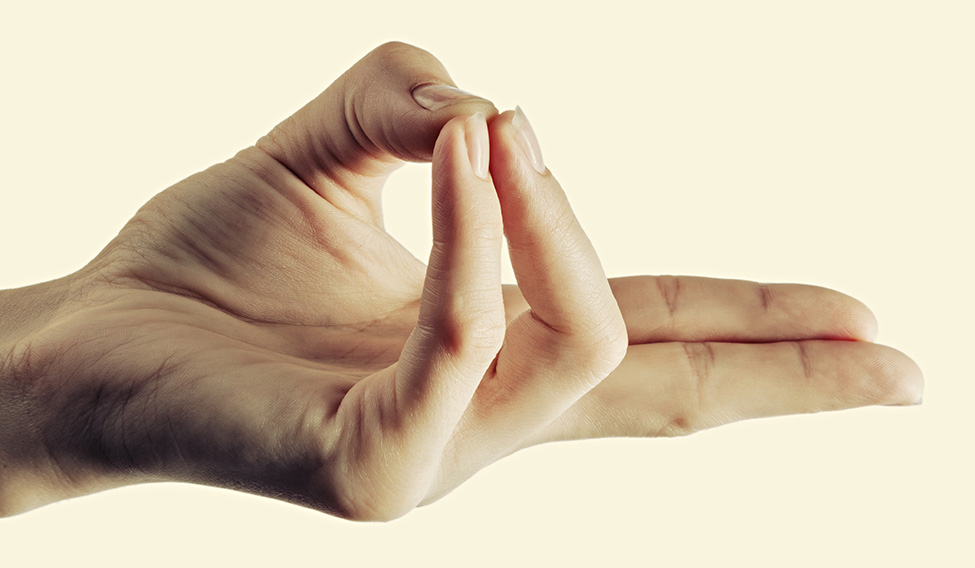Everything about Sonal Joshi, a Gujarati who lives in Kerala, is mild. When she speaks, her voice falls in soft folds about her. When she smiles, she does so in a gentle manner, and you get the feeling that smiling is a way of life with her. But she has learnt the lesson the hard way. Ten years ago, she was afflicted with spondylitis. That was the time her son was getting married. She had to shuttle between Gujarat and Mumbai to do all the wedding shopping. Then, she used to be a perfectionist who wanted things done in a particular way. She would go to the hospital in the morning, use traction and head out for shopping. On the day of the wedding, she was in a terrible condition. She flopped onto a chair and couldn’t get up. Many people came to her and asked her why she was not on the stage. The next day, she was admitted to the hospital.
“During that time, I was almost bed-ridden,” she says. “I had so many health problems. I underwent many surgeries which did me no good. I used to walk around with a back support belt. I couldn’t mix socially and was always tired.”
That is when she found out about a yoga university in Bengaluru that advocated an integrated yoga therapy, a combination of asanas, mudras and pranayama. They had a 250-bed hospital and Joshi got admitted there. She says that after the treatment at the university, she was completely cured. A few years ago, she learnt mudra therapy from a teacher in Nasik. Currently, she is doing her MSc in yoga and conducts mudra classes in Kochi, Kerala.
“In our bodies, there are meridians and pranic energy flows,” she says. “Energy is emitted from the tips of your body—nose, chin, fingers, ears…. This energy dissipates into the cosmos. Mudras can redirect the energy back into the body and use it for healing purposes.”
According to Mudras for Healing and Transformation by Joseph and Lillian Le Page, “mudras are gestures of the hands, face and body that promote physical health, psychological balance and spiritual awakening…. The word mudra is derived from two root words: mud which means delight, pleasure or enchantment and rati, which means ‘to bring forth’. Mudras bring forth our own inherent delight and enchantment, which are always present and waiting to be awakened.”
The basic premise of healing through mudras is that each finger of your hand represents one of the five elements—fire, water, space, earth and air. Diseases happen when there is an imbalance in any of these elements and mudras help to balance them. Each mudra channels the breath to a particular part of the body and, according to the Le Pages, “the breath is the primary vehicle for prana, the life force energy. By channeling the breath into specific areas of the body, mudras enhance our sensitivity to the flow of the subtle energy, removing energy blockages and thereby reestablishing the free flow of prana.” They say that specific gestures cultivate balance within each facet of our subtle anatomy, including the energy centres or the chakras, the energy currents or the prana vayus and the energy channels or the nadis.
 Finger magic: Komal Jambotkar and her parents used mudras to get relief from specific medical conditions | Amey Mansabdar
Finger magic: Komal Jambotkar and her parents used mudras to get relief from specific medical conditions | Amey Mansabdar
“Some of the mudras can balance an element in the body in 45 minutes or less, while others have an immediate effect,” says Joshi. “Practising mudras regularly can cure sleeplessness, arthritis, memory loss, heart problems, incurable infections, blood pressure, diabetes and many other ailments. Mudras are universal and can be performed anywhere, anytime and by anybody. As there are no medications involved, one need not worry about the side effect of chemicals in the body. The science of mudras is very exact and perfect.”
Anyone familiar with yogic healing will have basic knowledge of the five elements, the five prana vayus, the seven chakras and the ayurvedic doshas. But all this might just be hogwash for the sceptic. Where is the evidence that it works? He will ask. Unfortunately, there are very few scientific studies done on healing through mudras. This, however, cannot be reason enough to shun completely their medicinal properties.
“It is a basic principle in physics that whenever there is flow of electricity, a magnetic field is created around it,” says Dr Rajesh B. Iyer, consultant neurologist and epileptologist at Vikram Hospital, Bengaluru. “The nervous system is nothing but electric channels carrying current all over the body. So, yogic postures and mudras are likely to have an influence on the micro-electromagnetic forces in our body and impact functions. Functional MRI studies show that certain areas of the brain get activated merely by thoughts even without carrying out a task. So, meditation, the process of "thoughtless awareness" is likely to impact brain functions. Breathing is an automatic phenomenon. The rate and depth of respiration varies automatically as per our body’s requirements. Even the airflow through nostrils is unequal with one side being dominant. By practising pranayama we can modify this automated process to influence bodily functions.”
If the ‘how’ has not been answered yet, there seems to be plenty of examples of the ‘what’. Iyer himself was part of a study on yoga and epilepsy at Sree Chitra Tirunal Institute for Medical Sciences and Technology, Thiruvananthapuram, where his team found out that seizures can be controlled through yoga. The mudra used for this study was the chin mudra, where the tips of the thumb are joined to the tips of the index finger of each hand, forming a circle. According to the Le Pages, the gesture facilitates “full yogic breathing, expanding breath, awareness and energy along the entire front of the torso”.
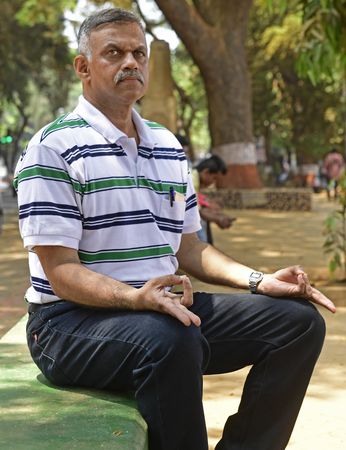 Mudras over medicines: Milind Deshpande says that mudras worked where modern medicine failed | Amey Mansabdar
Mudras over medicines: Milind Deshpande says that mudras worked where modern medicine failed | Amey Mansabdar
Iyer refers to the homunculus model of the brain. The cortical homunculus is a “neurological map of the body” in the brain or the way in which different parts of the body are represented in the brain. Interestingly, sensory nerves from the hands terminate over the largest area of the brain. Hence, the hands of the homunculus man are huge. In contrast, the torso is tiny because there is not much sensory representation of the torso in the brain. The largest sensory representation in the brain is of the hands so if you apply pressure to certain parts of the fingertips, it is possible that significant areas of the brain could be stimulated.
But could healing through mudras simply be a placebo effect? “A large part of the motor cortex of the brain is dedicated to hand movements,” says Dr Shyam Bhat, psychiatrist and founder, Seraniti.com. “So mudras may have health benefits, especially for mind-body/psycho-somatic conditions like back pain and head ache. The motor control of your limbs is also determined by the cerebellum in the brain and emerging evidence suggests that the cerebellum plays a significant role in mental health. In a condition like anxiety, there is an imbalance of right and left hemispheres of the brain. Mudras could balance hemispheric activity. Of course, this is just a theory and no conclusive study has been done on this. The mudras also may help the mind by symbolism and metaphor. In patients suffering from anxiety, for example, I’ve noticed that their hands are often held tight as if they are holding on to something and can't let go and often tension develops in the area between the thumb and the forefinger. And so, a hand position that reminds you about the metaphor of letting go can be deeply relaxing to the mind.”
Bhat gives the example of the anjali mudra (the prayer position in which both hands are held together, palms facing each other). “There is a theory that this causes the two halves of the brain and the body to come together, and also perhaps induce feelings of gratitude and benediction,” he says. “Physical changes can cause changes in mood. Archetypal gestures like the anjali mudra could have deep meaning. Most doctors would rightly say this is just speculation, but mudras deserve serious study, to see how it can fit into an integrated and holistic approach to healing.”
While there are many sceptics, there are many others who say that mudras have helped heal their diseases. I spoke to some patients of ayurvedic doctor Dilip Potnis. Komal Jambotkar, a 24-year-old chartered accountancy student, says that initially she was sceptical. “I didn’t see how a medical condition could be treated without medicines. I had polycystic ovarian disease (PCOD). My periods were never regular and there would be heavy bleeding for up to a month. My father took me to Dr Dilip Potnis who recommended that I do apana and prana mudras for two months. I used to do it while watching TV or during my studies and immediately got relief from my condition. It was very effective. The bleeding stopped. You can do it anywhere, my doctor told me. The only condition is that you should be sitting while doing it. Only prana mudra can be done while standing. My father suffered from constipation and my mother from diabetes. These, too, were brought under control through mudras. My mother’s diabetes came down from 300mg per decilitre to 150mg per decilitre.”
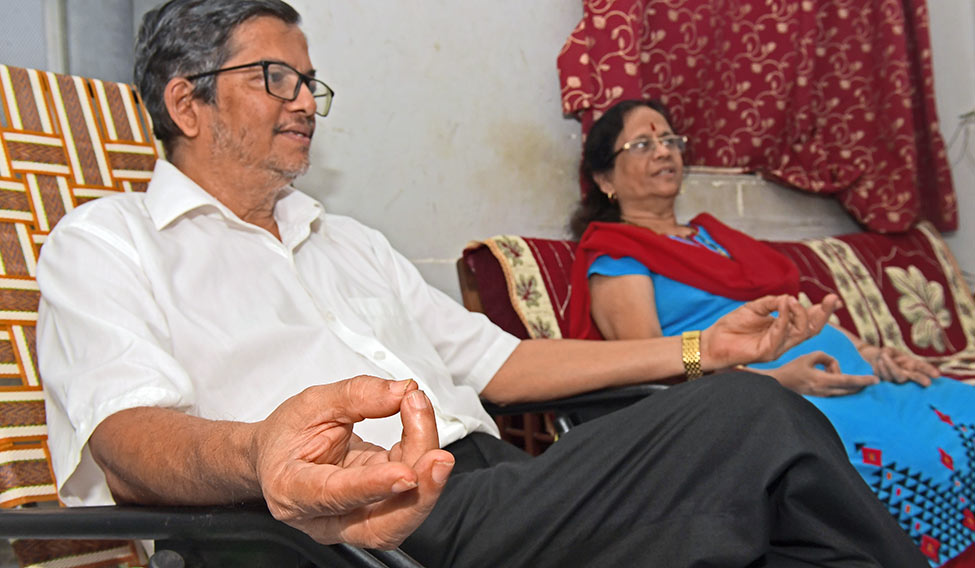 Disease destroyer: Anil Mayekar says that in the three years since he started doing mudras, he hasn't taken a single tablet | Amey Mansabdar
Disease destroyer: Anil Mayekar says that in the three years since he started doing mudras, he hasn't taken a single tablet | Amey Mansabdar
Chemical engineer Milind Deshpande, 53, says that mudras have definitely been more beneficial to him than modern medicine. “My daughter had chronic cough, cold and allergy problem,” he says. “Our doctor would prescribe medicines but the condition would recur after a few days. She started practising linga mudra in two sessions of 10 minutes a day. Linga mudra helps increase heat in your body. The effect was dramatic. Within a few sessions her condition was brought under control. My wife had an issue with bone density. Her back would start paining when she had to stand for a long time. She started practising akasha mudra before meals and that helped to enhance calcium absorption from food. Within a month her problem disappeared and she stopped taking calcium tablets. Apana and prana mudras can be done for general wellbeing, linga mudra and akasha mudra for specific conditions. When the condition goes, you can stop doing the mudras.”
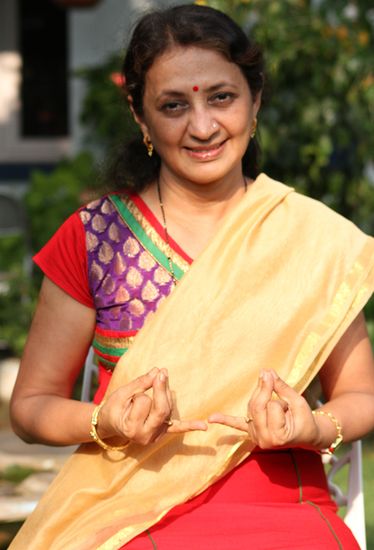 Up and about: sonal joshi says she was almost bed-ridden before she started using yoga and mudras to heal herself | Vikas Ramdas
Up and about: sonal joshi says she was almost bed-ridden before she started using yoga and mudras to heal herself | Vikas Ramdas
Anil Mayekar, 63, who works as a secretary in a company in Mumbai, says he started practising mudras three years ago. “After I started doing apana mudra, which is for getting rid of toxins in the body, I haven’t got any disease. In the three years since I started doing mudras, I haven’t taken a single tablet. Even when I get a cold or sneezing, I do linga mudra and I get relief when the water in my body dissipates,” he says. “I wake up at 3:15am and do apana mudra for 48 minutes. Then I go for a morning walk when I practise prana mudra for 48 minutes. Around 6am I rest for half an hour. I head to office at 8am. Even when I sit in front of the PC from 8am to 5:30pm I don’t get exhausted. Mudras have not just built my confidence and stamina but have also brought my diabetic condition under control. I also lead a simple lifestyle and eat non-veg only once a month. I don’t have words to explain how much mudra therapy has helped me.”
But can mudras really bring under control medical conditions like diabetes? I asked Dr Pradeep Gadge, diabetologist at Gadge Diabetes Centre, Mumbai.
“I was not aware of mudra therapy until a few years back,” he tells me. “In medical college you are made to believe that allopathy is the best branch of medicine. This is something I’ve been opposing for many years now. I like to read about ayurveda and homoeopathy. Five or six years ago, a patient told me that he had used mudras successfully and that sparked my interest in them. I believe that it is possible to treat certain chronic diseases like diabetes and arthritis using different finger postures. Every second patient I meet is not just stressed but is suffering from anxiety or depression. Their disease gets aggravated because of stress. Mudras combined with yoga alleviate stress and give you peace of mind, leading to an improvement in your medical condition. It is true that the psyche has a role to play in each and every disease, especially chronic ones. It is a fact that when you’re happy, neurotransmitters are produced that cause vasodilation of blood vessels. I advocate holistic medicine which combines all these different therapies, which will be effective for the betterment of the patient.”
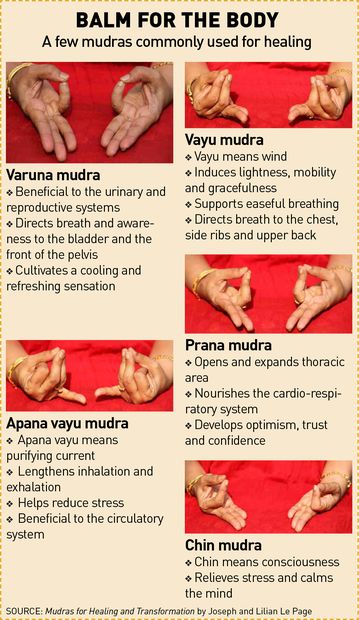
Dr B.K. Chandra Shekhar, healer and practitioner of psychoneurobics, says that there are two types of energy in the body. The first is the biochemical energy which can be tested in the laboratory through a drop of blood. This is the energy that comes from food. Suppose you have a deficiency of iron or calcium in the body, the doctors and scientists will be able to rectify it. But they can’t do anything about the second type of energy which is the bioelectrical energy or the spiritual energy. “God is the only source of this,” says Chandra Shekhar. “Spiritual energy can be converted into emotional energy which is carried to the body through the mind. The mind is the instrument that can change thoughts and emotions into energy, just like how a bulb changes electrical energy into light energy. This energy is then sent to the brain which turns it into chemicals. Happy energy, for example, leads to the release of what’s known as the happy hormone. Neural law means closing one nerve and allowing energy to pass through another nerve. So, for example, the prana mudra will send energy to the brain. The agni mudra will direct it to the abdominal region.”
But can it be proved that energy can be distributed in the body? “It is absolutely possible to split energy and direct it to different parts of the body,” says Dr Padmini Krishnan, a kuchipudy dancer and a diabetologist. “For a dancer, this is through body movement and foot work. I have been dancing for 31 years now. I’ll watch a student’s foot movement and say: don’t put so much energy there. I know exactly how to spread the energy in my body. But this comes only through practice. It’s just like learning to drive. You need practice to learn when to press the clutch and when to change the gear.”
Krishnan, like any good dancer, has a natural grace about her. Not just her face, but her whole body is expressive. To emphasise a point, she uses a specific body posture. When she shows me a mudra, her body seems to align with the emotion that the mudra is used to express. She communicates with her body, not just with her voice.
“There are three categories of mudras in kuchipudy,” she tells me. “Thirteen samyuta hasthas in which you use both hands, 24 asamyuta hasthas and 29 nritta hasthas. This is based on Bharatamuni’s natyashastra. There are two aspects to healing through dance. There is the physical healing that takes place with one’s knowledge and then there is the psychological healing which takes place without one’s knowledge. There are several flexor, extensor and abductor muscles in the hands. There is no doubt that mudras help to strengthen these muscles. One of my students used to be an infantile hemiplegic girl who couldn’t move her hands and now, through the use of mudras and dance, she can. Mudras can also increase movement in those with movement restriction and relieve the pain of those suffering from conditions like arthritis.
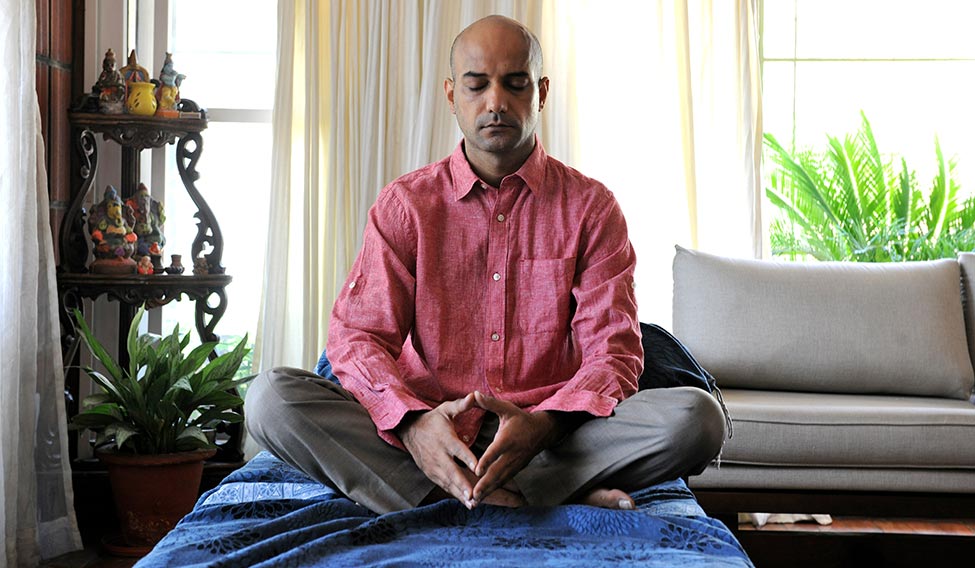 Relaxation mantra: Dr Shyam Bhat says that in a condition like anxiety, where the hands are held tight, a hand position that reminds you of the metaphor of letting go can be relaxing to the mind | Bhanu Prakash Chandra
Relaxation mantra: Dr Shyam Bhat says that in a condition like anxiety, where the hands are held tight, a hand position that reminds you of the metaphor of letting go can be relaxing to the mind | Bhanu Prakash Chandra
Take carpel tunnel syndrome. The median nerve lies under the tunnel of the wrist joint. In this disease, there is a thickening of the band that leads to compression inside and affects the median nerve which, in turn, affects the thumb, index finger, middle finger and half of the ring finger. This leads to numbness and a tingling sensation. Mudras can improve and prevent this condition. In systemic lupus erythematosus, the hand movement is restricted and in de Quervain’s tenosynovitis, there is painful inflammation and the thumb is affected. In this case, one can do thumb extension mudras like shikharam and mushti. The transformation from one mudra to another also helps. We use different mudras to flex, abduct and adduct. For example, strengthening of the muscles and stretching of the tendons are possible through mudras like tripataka, mukulam and aralam.”
The hands are also great storytellers, not just of the trajectory of your life but of your health as well, writes paediatrician Dr Gita Mathai in her blog post on medical palmistry. People with mental illnesses, for example, have more open loops and fewer whorls on their fingertips. If your index, middle and ring fingers are of the same length, then you might be suffering from congenital hypothyroidism and certain renal diseases. Obese people tend to hold their hands with their thumbs facing backward when they stand. People of normal weight stand with their palms facing forward. There might be great secrets hidden in your fingers. It is now the role of science to dig them out.




